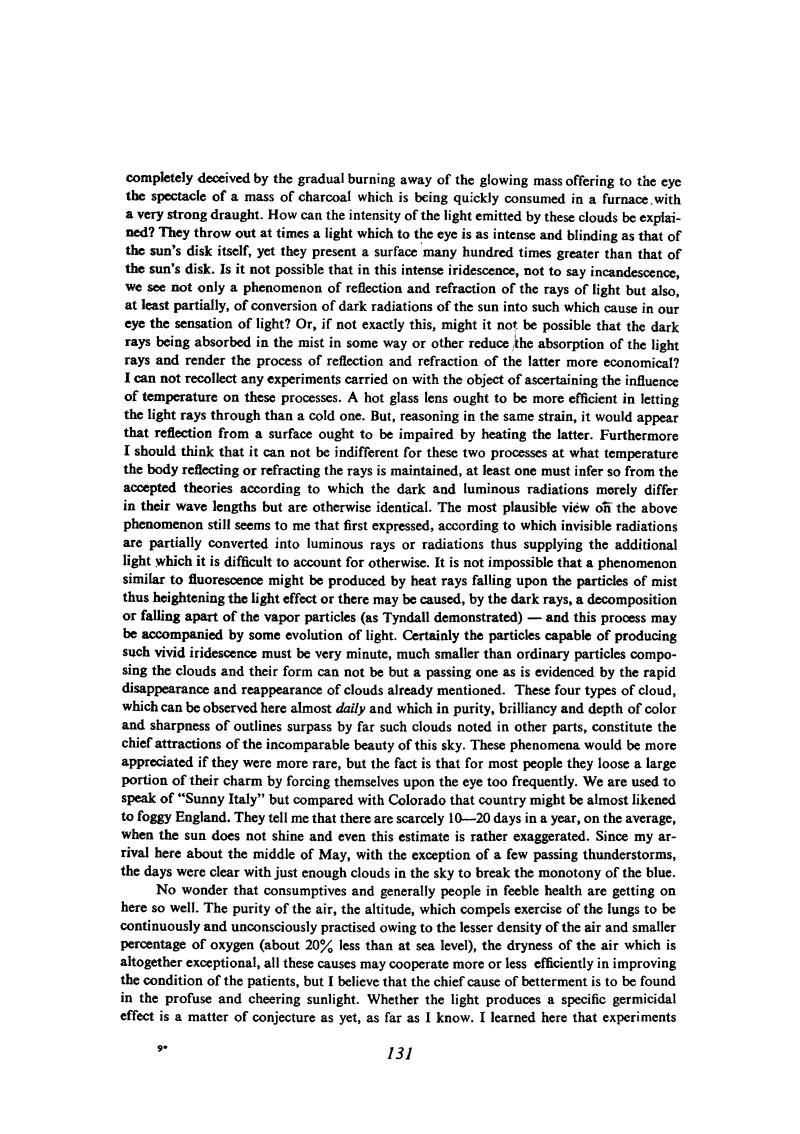
Nikola Tesla Books
completely deceived by the gradual burning away of the glowing mass offering to the eye the spectacle of a mass of charcoal which is being quickly consumed in a furnace with a very strong draught. How can the intensity of the light emitted by these clouds be explained? They throw out at times a light which to the eye is as intense and blinding as that of the sun's disk itself, yet they present a surface many hundred times greater than that of the sunâs disk. Is it not possible that in this intense iridescence, not to say incandescence, we see not only a phenomenon of reflection and refraction of the rays of light but also, at least partially, of conversion of dark radiations of the sun into such which cause in our eye the sensation of light? Or, if not exactly this, might it not be possible that the dark rays being absorbed in the mist in some way or other reduce the absorption of the light rays and render the process of reflection and refraction of the latter more economical? I can not recollect any experiments carried on with the object of ascertaining the influence of temperature on these processes. A hot glass lens ought to be more efficient in letting the light rays through than a cold one. But, reasoning in the same strain, it would appear that reflection from a surface ought to be impaired by heating the latter. Furthermore I should think that it can not be indifferent for these two processes at what temperature the body reflecting or refracting the rays is maintained, at least one must infer so from the accepted theories according to which the dark and luminous radiations merely differ in their wave lengths but are otherwise identical. The most plausible view on the above phenomenon still seems to me that first expressed, according to which invisible radiations are partially converted into luminous rays or radiations thus supplying the additional light which it is difficult to account for otherwise. It is not impossible that a phenomenon similar to fluorescence might be produced by heat rays falling upon the particles of mist thus heightening the light effect or there may be caused, by the dark rays, a decomposition or falling apart of the vapor particles (as Tyndall demonstrated) - and this process may be accompanied by some evolution of light. Certainly the particles capable of producing such vivid iridescence must be very minute, much smaller than ordinary particles composing the clouds and their form can not be but a passing one as is evidenced by the rapid disappearance and reappearance of clouds already mentioned. These four types of cloud, which can be observed here almost daily and which in purity, brilliancy and depth of color and sharpness of outlines surpass by far such clouds noted in other parts, constitute the chief attractions of the incomparable beauty of this sky. These phenomena would be more appreciated if they were more rare, but the fact is that for most people they loose a large portion of their charm by forcing themselves upon the eye too frequently. We are used to speak of âSunny Italyâ but compared with Colorado that country might be almost likened to foggy England. They tell me that there are scarcely 10 - 20 days in a year, on the average, when the sun does not shine and even this estimate is rather exaggerated. Since my arrival here about the middle of May, with the exception of a few passing thunderstorms, the days were clear with just enough clouds in the sky to break the monotony of the blue.
No wonder that consumptives and generally people in feeble health are getting on here so well. The purity of the air, the altitude, which compels exercise of the lungs to be continuously and unconsciously practised owing to the lesser density of the air and smaller percentage of oxygen (about 20% less than at sea level), the dryness of the air which is altogether exceptional, all these causes may cooperate more or less efficiently in improving the condition of the patients, but I believe that the chief cause of betterment is to be found in the profuse and cheering sunlight. Whether the light produces a specific germicidal effect is a matter of conjecture as yet, as far as I know. I learned here that experiments
9*
131
Tesla: âMethod of utilizing effects transmitted through natural mediaâ, U.S. Patent 685 954, Nov. 5, 1901, Appl. Aug. 1, 1899, P-303.
August 1
Extraordinary atmospherics in vicinity of laboratory instigated Tesla to devote some time to phenomena which are the consequence of a clean environment, dry air and low pressure. In such atmosphere sun and moonlight are more intensive than usual, the visibility is better, and even sounds propagate with less damping. The air is highly electrically charged, and according to Tesla that could be among other reasons, one of the reasons for this phenomena. Although the surrounding itself is not considered particularly attractive, Tesla is impressed with clouds, sunrise and sunset. His descriptions of these events are (literally - Editor) extraordinary, although they lack scientific preciseness and a systematical approach. This particularly pertains to descriptions of cloud types, and the description of some clouds' brightness which are brighter than the sun itself. Radiations, transformations of one kind of radiation to another and similar effects are known topics to Tesla and he uses his knowledge for the explanation of the events around him. In his considerations he grasped even the biological aspects of sun rays and atmosphere, and when he mentioned X-rays in connection with sun radiation, he expressed his hope that he will produce such intensity of these rays which will cure tuberculosis!

